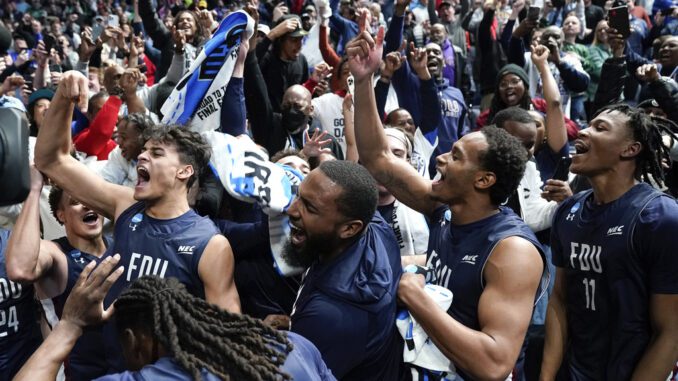
There is something so quintessentially American going on during March Madness that we need to keep it in mind every day of the year and remember why we love it so.
Strange behavior of male rabbits in March was recorded as early as 1500 in Europe, which led people to say they were “mad” or crazy. Hares were seen jumping vertically for apparently no reason; kicking at nothing but thin air and boxing other hares for territorial rights. They weren’t insane, of course, but just doing what nature intended for male rabbits to do during the spring mating season.
Hence, the figurative image of the Mad March Hare was born.
There was, of course, the fictional March Hare in Lewis Carroll’s admittedly strange “Alice’s Adventures in Wonderland,” published in 1865 and popularized in Disney’s 1951 animated film, who epitomized crazy thinking and behavior. “Ah, but that’s the point! If you don’t think, you shouldn’t talk!” the March Hare would reason. “I have an excellent idea! Let’s change the subject,” which sounds like he works in the Biden White House.
Sports fans think Brent Musburger came up with the term “March Madness” spontaneously during the 1982 tournament, but he later said he remembered reading it as a young sports journalist while in Chicago.
Indiana assistant executive secretary of the Illinois High School Association and basketball enthusiast Henry V. Porter coined the phrase “March Madness” in 1939. He penned a somewhat saccharine essay by today’s standards in which he paid homage to the thousands of rabid Illinois high school basketball fans who followed their teams across the state in the year-end tournament that was open to all teams, large and small.
Think of the movie “Hoosiers” except in Illinois, not Indiana.
There is nothing “crazy” about March Madness and the NCAA college basketball tournament. March Madness is a celebration of pure, get-it-done American meritocracy. We should celebrate an entire year of monthly madness if that is what it takes to restore American pride in our collective citizenship.
There is no amount of socialism, CRT, DEI, BLM, antifa, ESG or any other form of government intervention that can change the outcome of any game if one team outperforms the other on the court. Neither can any amount of money for coaches’ salaries, recruiting or NIL ― the team that carries out its game plan and imposes its will on the other team wins, regardless of how many Diaper Dandies and One-and-Doners are on one team when none are on the other.
It doesn’t matter how many black players are on your team (Fairleigh-Dickinson – 10 out of 12) or how many white players are on your team (Princeton – nine out of 16). If your team can make open shots, play tenacious defense, be unselfish, pass the ball to the open person and play as a team, they can win on any given night.
Purdue was ranked No. 1 much of the year and had a 7-foot-4 giant, Zach Edey, in the middle. The Fairleigh-Dickinson Knights ― Lilliputians by comparison ― are the shortest team of all 353 NCAA D-1 schools with an average height of 6’3”.
The Boilermakers’ coach, Matt Painter, enjoys a salary of $3.55M per year. Fairleigh-Dickinson’s enigmatic coach, Tobin Anderson, makes $40,000 per year.
That’s right ― $40,000. Per year.
FDU’s NIL budget might be a dozen doughnuts and a to-go box of Starbucks coffee compared to Purdue or any of the blue blood teams now out of the tournament such as Duke, UNC and Kansas.
Based on metrics and history, there was no conceivable way the 16th-seeded Knights of FDU could defeat Purdue in the first round. And yet they did. They used the two most deadly tools in all sports ― speed and quickness ― and combined it with a full-court press the entire game to upset the Boilermakers.
The crowd in the Columbus, Ohio, arena went “mad” cheering on FDU. So did millions of fans outside of West Lafayette, Indiana, watching on TV, most of whom had no idea of where Fairleigh Dickinson is from (Hackensack, New Jersey). They didn’t care if the FDU players were black, white, rich or poor. Fans from other colleges were cheering equally as loudly as the FDU fans and families. All they could see was extraordinary effort and heart on the court, and they couldn’t help but act like March hares jumping up and down wildly in the spring when they won.
FDU upsetting Purdue was not just David versus Goliath. It was a celebration of what living in America can be like if we pull for each other and not tear each other down all the time.
We are on the same team as Americans. We can all do this.

